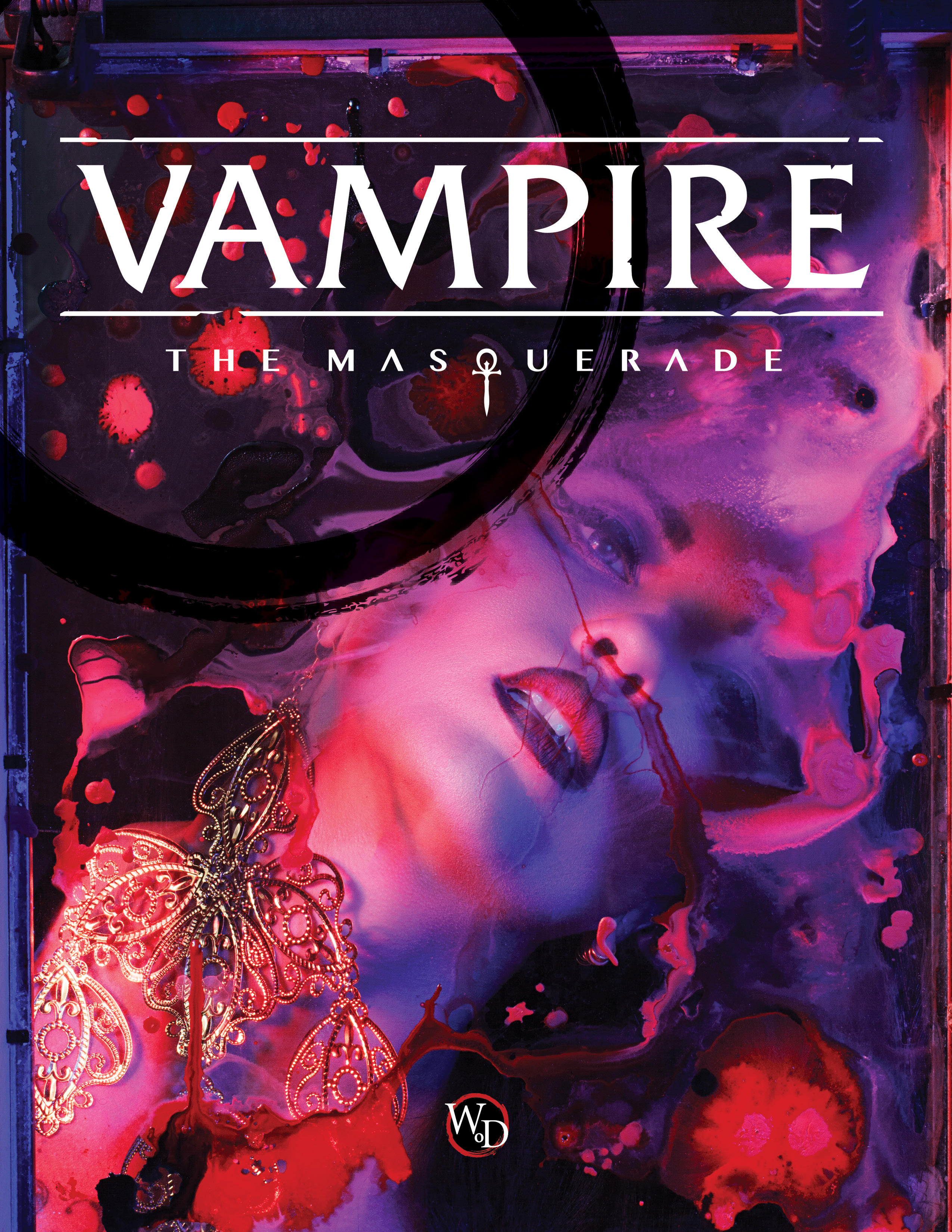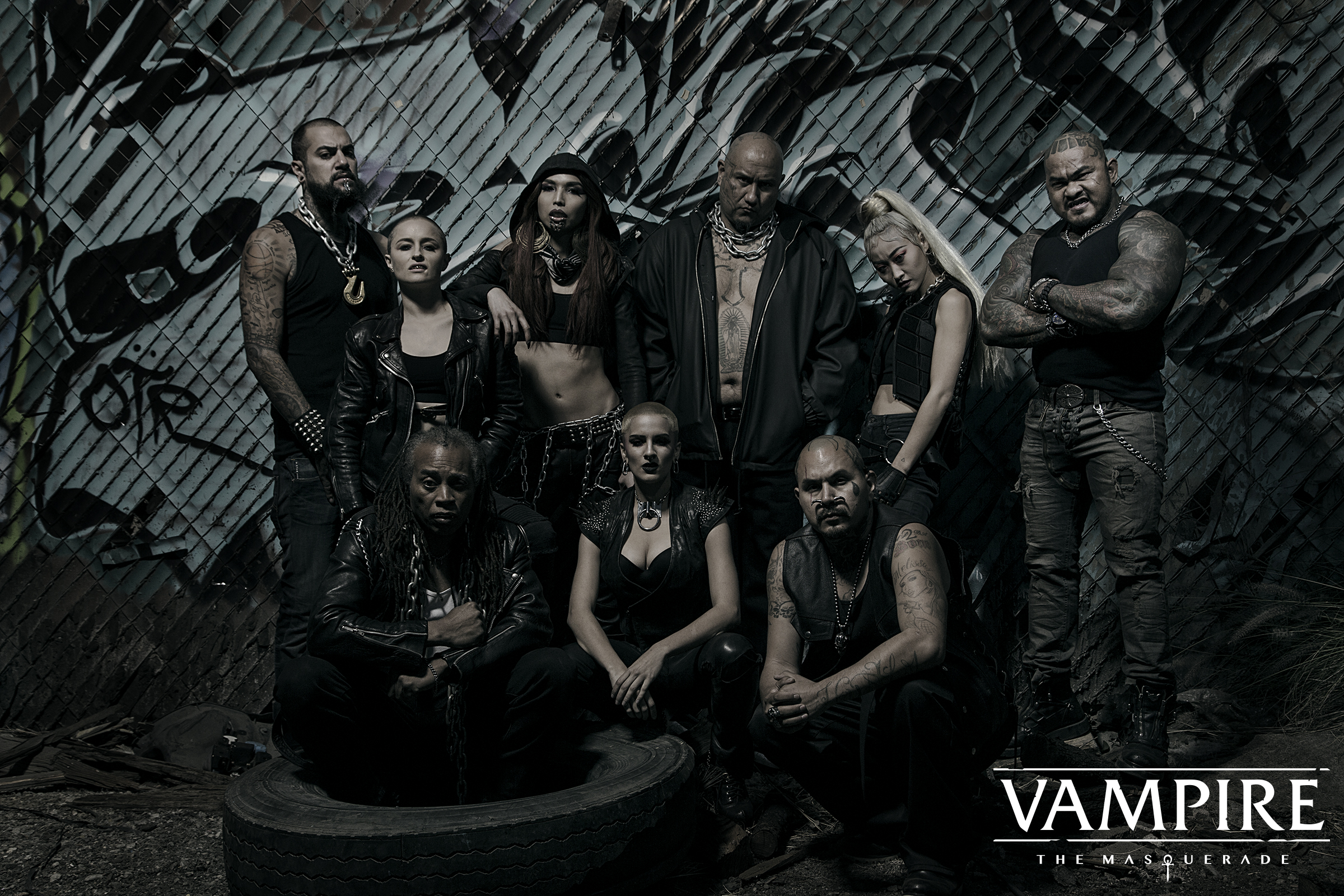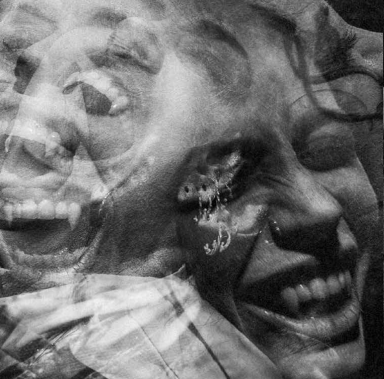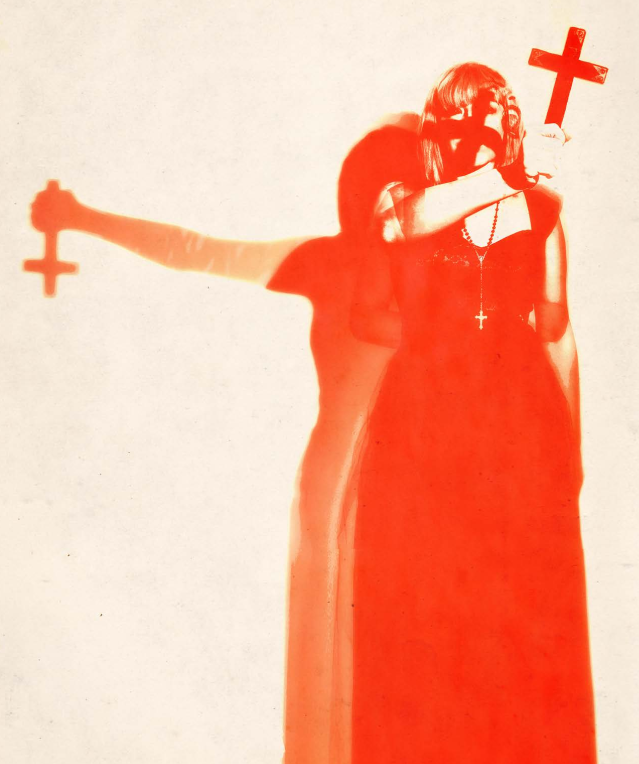Vampire: The Masquerade finally returns to the tabletop with big changes
White Wolf awakens the World of Darkness from torpor with this look inside Vampire: The Masquerade 5th Edition.

After 15 years out of the spotlight, the World of Darkness is finally back. The resurrected White Wolf, purchased and set loose by Paradox Interactive, has finally put the venerable world of urban fantasy and horror back on the tabletop with Vampire: The Masquerade 5th Edition. I’ve read it, played it, and I spoke with some of the people from White Wolf about the wild new gameplay changes, and how The World of Darkness is being updated with new secret histories to reflect on 15 years of world events. They have big plans for the future of the setting on tabletop, PC, and even beyond that.
For tabletop and live action roleplayers, this is an event of a magnitude that’s hard to describe to people who’ve only experienced World of Darkness through videogames like Vampire: The Masquerade - Bloodlines or Hunter: The Reckoning. Imagine if The Elder Scrolls abruptly ended after Morrowind in 2002, only to re-emerge all these years later—World of Darkness is that popular a set of game lines, that much of a common touchstone for people in the tabletop RPG world.
What made the original Vampire: The Masquerade special was its decision to cater to an adult audience, its new and unique graphic design, and its attempts to engage critically with themes in modern society. The World of Darkness courted controversy, and still does, but the games deserve credit for making an earnest attempt. It’s a sprawling neo-Gothic urban fantasy world incorporating many games beyond Vampires, each with their own themes: Werewolves, Mages, Hunters, Changelings, Wraiths, Demons, and yes, even Mummies. It became a pervasive influence on other fantasy worlds well into the 21st century.
In 2004, the last significant games and books for the World of Darkness were published. Vampire: The Masquerade, the game that for so many had revolutionized the very idea of what you did in a roleplaying game, was gone. Symbolically, 2004 is the same year that Troika’s Vampire: The Masquerade - Bloodlines videogame released as an incomplete, broken mess. Bloodlines went on to become a cult classic, fixed by an adoring community not just because it was good but because it was some of the last of the World of Darkness as it was.

I spoke with White Wolf creative director Martin Ericsson and CEO Tobias Sjögren in Stockholm a few months ago, just before the finalizing and printing of Vampire: The Masquerade 5th Edition (or V5). At the time I’d only played a fragment of the game: a few hours of an alpha, then a few hours of beta playtest with near-final rules. Not nearly enough to get a bite of rules that are meant for hundreds of hours of play. Now I’ve sunk my teeth into the review copy of the book, played a bit more, and have a deeper understanding of what they said.
One of the first things I learned speaking with Sjögren was that the World of Darkness wasn’t what I thought it was. It’s no longer a game setting—those 90s days are long over—but a proper 2018 ‘IP,’ or a collection of them. People from White Wolf say IP a lot. But the tabletop game is still the crux of it.
“The pillar, the foundation stone of this, is the tabletop RPG,” said Sjögren. “That’s why 5th edition Vampire is something Martin has put all his soul into.”
Keep up to date with the most important stories and the best deals, as picked by the PC Gamer team.
That's Martin Ericsson, who is in charge of coordinating storytelling across every in-production World of Darkness product, but gave special attention to V5. As we talk, he's often carried away by his excitement for the game worlds he has stewardship over.

Updating the rules
In older editions of Vampire, the rules are an absolute mess, nigh on unplayable in places, broken beyond the very concept of balance in others. The core of the rules were fine, and those are still much the same in V5: Rolling a handful of ten sided dice and counting the ones that show a six or higher to know how well you did. Old Vampire’s deeper game system was barely qualified to use the name it did—”Storyteller.” The system as a whole was bogged down with figuring out absurd power interactions, tracking points of blood victim-by-victim, and the minutiae of mechanics like swimming and falling and climbing and rolling to drive cars. Feeding on and using blood is the most egregious offender. Blood was tracked in points like it was mana, and a vampire never really got hungry so much as low enough on juice to stop for a refill. It was divorced from the reality of the world outlined in the Vampire books, where a Kindred was always about to snap from the strain of not eating everyone they saw.
Talking to Ericsson and Sjögren, I delicately broached the subject of mechanical design in the new game. “Some people will say it has not aged well,” I said.
“Oh, oh yeah," said Ericsson. "I would be one of them. And that I think is the first thing—love is not enough, if you just blindly love something then you will be unable to tweak it and better it and so on.”

Ericsson shows outright distaste for the stranger, more immersion breaking mechanics of old Vampire.
The new game focuses on the themes that Vampire has always professed to follow, but never quite enforced. It’s exploring what it means to be evil. Its systems more elegantly balance the ravenous hunger and need to appear human of vampires, and the push-pull between monster and Masquerade is at the very core of the game. It shows up in everything you do. V5 also more specifically and thoroughly supports the spiraling degradation of a vampire’s Humanity, something past editions—and their players—often glossed over in favor of blood fueled nighttime anti-heroics.
The developers had to “shed some of the heritage of simulation and go to something that more inspires roleplaying around the table” in order to get at the heart of Vampire, said Ericsson. White Wolf’s designers kept the simulationist heart of the game: Your characters still have individual ranks in specific skills, they have stats like Strength or Wits, and derived stats like Health or Willpower. Stuff like that weird mana pool of a blood system? Gone.
Ericsson shows outright distaste for the stranger, more immersion breaking mechanics of old Vampire. “It’s not like you’re tracking blood points like you’re tracking a gas meter. You replace regular dice with red dice, which are hunger dice, so you constantly see where your hunger is.” Once you’re hungry, and it’s easy to get hungry, any time you roll dice to do anything you’ll roll those Hunger dice too. It’s a system designed to bring addiction and a vampire’s bestial nature to the fore: “You constantly have that danger of losing your shit.” If those red Hunger dice roll a one or a ten then things get messy. Successful roll or not your character gets bestial, savage, red in tooth and claw searching for their next fix.
In motion it works better than it used to. Though some of the game is still granular and simulationist, new rules for conflicts, damage, and hunting streamline the boring parts of the old game into friendlier mechanics that actually tell stories rather than hinder them. Hunting up some blood, for example, is easy. Getting enough blood to sate yourself forces a choice between time and convenience, with a cost in human life if you choose convenience.

You’re a predator scanning for prey at all times.
Sjögren thinks much of that strength in the system is because it has been designed with the knowledge that its world exists outside the context of just the pen and paper roleplaying rules. He makes a strong argument: “Few have had the opportunity to create a tabletop RPG with the knowledge that there will be other products based on it, not only computer games, but other stuff as well, and take that into account.”
For his part, Ericsson thinks some of the system and revised world lore dovetail together from an unexpected place: His work on the cancelled CCP World of Darkness MMO. “A clear example that actually comes from the MMO development was to look closer at blood, and the effects of blood in the vampire’s physical system, and how it affects hunger, and how it affects their disciplines and powers, and how it makes them feel,” he said. Trying to figure out the core gameplay of the MMO led designers to the grind—the currencies and items to collect and tasks to do. It was stumping them.
“In some meeting,” says Ericsson, “I just said ‘Dude, these are vampires, they hunt for blood every night. That’s a grind, right?’ So then we worked in the idea that how a person feels, a person’s biography and state of mind, their current state of mind, affects how the blood kicks. So it can kick up your Potence [Vampiric strength] if somebody is like scared and full of anger, or if you seduce someone it could kick up your Presence [Vampiric charm] as well, and that suddenly makes every NPC in the world interesting.”
Under the V5 blood system, hunting becomes a constant activity and feeds directly into the roleplaying. You’re a predator scanning for prey at all times. You’re listening intently as the game master describes the club, hoping for a raver on an amphetamine trip because you want to kick up your supernatural speed for the inevitable fight with the Ghouls hogging the bar.
Most of the systems, especially Hunger and Humanity, are designed to move forward to other games in the World of Darkness, said Ericsson. “The base system we made here will be the same for, you know, Rage management [in Werewolf], and Paradox in Mage, and so on.”

A 21st Century World of Darkness
Ericsson is genuinely excited about the idea of bringing World of Darkness, and Vampire, forward into the 21st century because they’re supposed to be critical games, games that engage with social issues and are intended for adults.
“That’s the beauty of the World of Darkness games,” he said. “They take the old gothic horror archetypes and they take an irreverent and relevant spin on them. That’s so enticing to do in a world, a geek world, that has discovered heightened discourse, even if it ends up really messy and so on, there are actual issues being debated!”
Ericsson and his team at White Wolf looked hard at the original Vampire: The Masquerade, trying to understand what was intended with the world and get at its core stories. To hear him describe it, they had a big goal: “We try to make the World of Darkness as shockingly new and as groundbreaking as it was back then. That marble cover with the rose that looked like an album cover. Timothy Bradstreet’s photorealistic drawings, which are his friends, rocker friends, we want something that feels as different from today’s urban fantasy as that.”

"The world has changed and the world of monsters has changed," says Ericsson. That meant a lot of recent history to sort through and cultural forces to reckon with—including forces outside America, which the World of Darkness’ new global focus demanded. They realized they needed another hand and decided on Kenneth Hite, an old hand in the RPG design world responsible for games like Trail of Cthulhu and Night’s Black Agents. Hite is a specialist in history, alternate histories, conspiracy theories, and the occult, as well as a widely-recognized expert in tabletop setting and scenario design.
Hite’s influence is clear to anyone familiar with his work: V5 presents a world intensely in tune with modern geopolitics and cultural trends. It's rife with mystery, conspiracy, and questions with no answers. Characters are presented with ways to be part of, or caught up in, various conspiracies and past events. It restores some of the mystery that 13 years of continuous metaplot had stripped from older editions of the game. It adds new terrors to the night, though they’re ones very familiar to anyone in 2018.
Vampires are hunted by a Second Inquisition under the auspices of unfettered world intelligence agencies with no rules and unlimited budgets, each backed by the big-data driven surveillance state. Ericsson jokes about vampires learning not to post on Reddit anymore. “I think for the vampire to work as an archetype they have to be both predator and prey,” said Ericsson. “That’s why you have the vampire hunter, always, as a thing.”

One theme Ericsson and Sjögren consistently, insistently put forward was the nature of the vampire characters the game depicts: They are "monsters." "Calling out some of the nastiness that’s inherent in some of the predatory patterns in vampires" is a priority, he said. Many vampires in the book do horrible things and hold horrible ideologies. "We’re not glamorizing these characters. These are nasty, nasty people."
You set the limits, you don’t have to display them all over the internet.
So much of what has made Vampire controversial—both in the past and more recently—is present in this book. But some of the most egregiously offensive content from the earliest editions of the game has been changed, removed, or scaled back. For example, the vampires of the Ravnos clan, originally a pejorative caricature of the Romani people, have been moved towards a more general depiction as hailing from the Indian subcontinent. When I asked Ericsson about how his team would reckon with that kind of history he was sanguine: “We try to have a high degree of research, we try to see things from multiple perspectives—everybody gets painted with a dark brush here.” It was an oddly neutral opinion on a setting that positions and presents itself as a critique.
As he spoke more, however, Ericsson seemed to find his real opinion: They intend their World of Darkness to be something shared and developed between adults, another talking point that he and Sjögren came back to again and again. "One of the beautiful things with tabletop roleplaying games are they are your affair," continued Ericsson. "You set the limits, you don’t have to display them all over the internet. The risk of context collapse is very small in a group of intimate friends, so as long as you talk to each other you can address more serious issues than say, a web series or a YouTuber could."

Negotiating that game context is incorporated into the mechanics. A vampire’s humanity is a vital statistic, one they have to keep high or suffer increasingly monstrous penalties, and some of the things that lower that humanity meter are decided by the players on a per-campaign basis. There’s a lot of guidance on how to do that. In contrast, there’s about 250 lukewarm words of guidance on actually handling adult themes and ensuring players are emotionally comfortable at the table. It’s literally the least they could do in light of the thousands of words of lore and campaign-building guidance.
This book is more a manifesto about White Wolf’s 2018 World of Darkness than about any supporting any single kind of player.
Thumbing through that lore I pretty quickly found thematic and story fodder for an easy five years of tabletop campaigns, but all of that new and interesting material was still weighed down by all the world’s accumulated history. I could move quickly because I already know a lot of the game’s made up words, vampire clans, and shadow-history slang. "Staying true to the old lore," as Ericsson put it, means that the book is littered with references to half-forgotten Vampire clans and movements, now-irrelevant events, and major players left only loosely described. Two supplementary books, Camarilla and Anarch, are planned to launch in October. It’s a hard ask as an entry point for new players.
In that succinct way—too much lore, not enough onboarding to roleplaying—it’s clear that new players aren’t the precise target of this game. They can play and have fun, but this book is more a manifesto about White Wolf's 2018 World of Darkness than about any supporting any single kind of player, new or old. As Sjögren said, these roleplaying books are the pillar of the World of Darkness IP. They’re effectively the setting bible for everything else to come—and White Wolf has a lot more planned.
Vampire: The Masquerade 5th Edition will begin appearing at retailers in August.
Jon Bolding is a games writer and critic with an extensive background in strategy games. When he's not on his PC, he can be found playing every tabletop game under the sun.

